
Looking for Canning Asparagus: Easy, Fully Illustrated Step-by-Step Directions and Recipe to Make Home Canned Asparagus! in 2025? Scroll down this page and follow the links. And if you bring home some fruit or vegetables and want to can, freeze, make jam, salsa or pickles, see this page for simple, reliable, illustrated canning, freezing or preserving directions. There are plenty of other related resources, click on the resources dropdown above. If you are having a hard time finding canning lids, I've used these, and they're a great price & ship in 2 days.
If you have questions or feedback, please let me know! There are affiliate links on this page. Read our disclosure policy to learn more.
Canning Asparagus: Easy, Fully Illustrated Step-by-Step Directions and Recipe to Make Home Canned Asparagus!
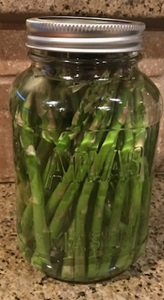 Canning Asparagus
Canning Asparagus
Asparagus is easy to can! All you need is a Pressure Canner (it is a very low acid food, so a plain water bath canner won't work). If a water bath canner is all you have, you can still make pickled asparagus (see this page). Here are the directions to can your own asparagus, so you can eat better, save money and have better tasting canned asparagus!
Note: asparagus is also sold in a white (blanched form of asparagus) and purple asparagus. Same process for those!
Ingredients
- Asparagus - raw, fresh. Use tender, tight-tipped spears, 4 to 6
inches long.
An average of 241/2 pounds makes a canner load of 7 quarts; an average of 16 pounds is needed per canner load of 9 pint jars. A crate of fresh asparagus weighs 31 pounds and yields 7 to 12 quarts - that's an average of 31/2 pounds per quart.
Equipment
-
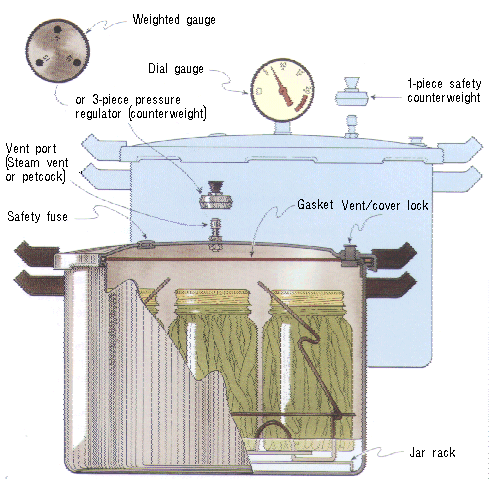 Pressure Canner - as mentioned in the introduction, you will need a pressure
canner. Like green beans and corn, asparagus does not have enough
acidity to prevent the growth of bacteria, and ordinary boiling water bath
canners don't reach the temperatures high enough to kill the spores.
Pressure Canner - as mentioned in the introduction, you will need a pressure
canner. Like green beans and corn, asparagus does not have enough
acidity to prevent the growth of bacteria, and ordinary boiling water bath
canners don't reach the temperatures high enough to kill the spores. - Jar grabber (to pick up the hot jars)
- Jar funnel ($4 at mall kitchen stores and local "big box" stores, but it's usually cheaper online from our affiliates)
- At least 1 large pot,
2 works better - Large spoons and ladles,
- Ball jars (Publix, Kroger, other grocery stores and some "big box" stores carry them - now about $12 per dozen quart jars (up 50% in 2 years!) including the lids and rings)
- Salt (optional - I don't use any)
Step by Step Directions
We're using photos of green beans since asparagus was out of season when we made this page, but the process is accurate!
Step 1 - Get your equipment ready
 This
is a good time to start a large pot of water boiling on low heat (to fill your
jars, around the asparagus; and also to start your canner heating
This
is a good time to start a large pot of water boiling on low heat (to fill your
jars, around the asparagus; and also to start your canner heating up (with the lid off and a few inches of water in the bottom - leave the heat
very low so you don't let it boil dry!). You can also get your canning
jars clea
up (with the lid off and a few inches of water in the bottom - leave the heat
very low so you don't let it boil dry!). You can also get your canning
jars clea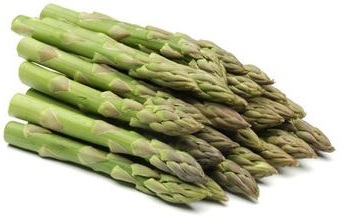 ning in your dishwasher. The pressure canner will ensure they
contents and the jars, lids, etc. are sterile, so you don't need to
pre-sanitize, but you certainly want to start with a jar that is clean!
Lids can start softening in a pot of hot, but not quite boiling water.
ning in your dishwasher. The pressure canner will ensure they
contents and the jars, lids, etc. are sterile, so you don't need to
pre-sanitize, but you certainly want to start with a jar that is clean!
Lids can start softening in a pot of hot, but not quite boiling water.
Step 2 - Wash the asparagus
Wash asparagus and trim off tough scales. Break off the bottom tough part of the stems (when you bend the stems in your hands, they tend to naturally break off when the stem starts to become tender) and wash again.
Step 3 - Cut to fit your jars
You can cut the spears to fit your jars (leaving room for 1 inch of headspace) or you can cut them into smaller sized pieces, as you prefer! Some people like whole spears, some like 1 inch pieces and some in between..
Step 4 - Pack the jars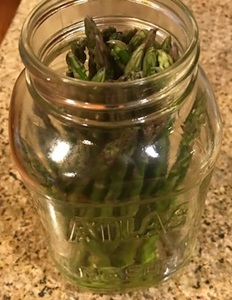
 We're
using the raw pack method here, since the jars will spend plenty of time in the
pressure canner at higher temperatures anyway! Fill jars with raw asparagus,
packing as tightly as possible without crushing, being sure to leave 1-inch
headspace at the top of the jar.
We're
using the raw pack method here, since the jars will spend plenty of time in the
pressure canner at higher temperatures anyway! Fill jars with raw asparagus,
packing as tightly as possible without crushing, being sure to leave 1-inch
headspace at the top of the jar.
Step 5 - Add salt, if desired
Add 1 teaspoon of salt per quart to the jars, if desired. It is only to suit your taste; it does not add any preservative properties here.
Step 6 - Add the boiling water
Add boiling water to the jars, again, leaving 1-inch headspace.

Step 7 - Seal the jars
Put the lids and rings on and make them snug, but don't over tighten them.
Step 8 - Put the jars in the canner and the lid on the canner (but still vented)
 Using the jar tongs, put the jars on the rack in the canner. By
now the water level has probably boiled down to 3 inches. If it is
lower than that, add more hot tap water to the canner. When all the jars
that the canner will hold are in, put on the lid and twist it into
place, but leave the weight off (or valve open, if you have that type of
pressure canner).
Using the jar tongs, put the jars on the rack in the canner. By
now the water level has probably boiled down to 3 inches. If it is
lower than that, add more hot tap water to the canner. When all the jars
that the canner will hold are in, put on the lid and twist it into
place, but leave the weight off (or valve open, if you have that type of
pressure canner).
Step 9 - Let the canner vent steam for 10 minutes
Put the heat on high and let the steam escape through the vent for 10 minutes to purge the airspace inside the canner.
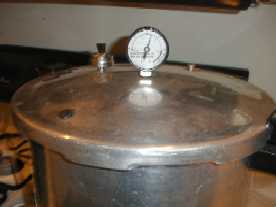 Step 10 - Put the weight on and let the pressure build
Step 10 - Put the weight on and let the pressure build
After 10 minutes of venting, put the weight on and close any openings to allow the pressure to build to 11 pounds.
Step 11 - Process according to the table below
Once the gauge hits 10 pounds, start your timer going - for 30-40 minutes - see the table below. Adjust the heat, as needed, to maintain 10 pounds of pressure.
Note: the chart at right will help you determine the right processing time and pressure, if you have a different type of canner, or are above sea level.
It is important to learn how to operate your pressure canner by reading the owner's manual that came with your particular canner. If you cannot find your owner's manual, you can obtain find one online: Here is where to find some common manufacturer's manuals:
or by contacting the company that made your canner. Give the model number to the manufacturer, and they will send you the right manual. Click here for more information about pressure canners and a variety of models you can order.
Adjust lids and process as recommended below, according to the method of canning used.
.
.
| Table 1. Recommended process time for Asparagus in a dial-gauge pressure canner. | ||||||
| Canner Pressure (PSI) at Altitudes of | ||||||
| Style of Pack | Jar Size | Process Time | 0 - 2,000 ft | 2,001 - 4,000 ft | 4,001 - 6,000 ft | 6,001 - 8,000 ft |
| Hot and Raw | Pints | 30 min | 11 lb | 12 lb | 13 lb | 14 lb |
| Quarts | 40 | 11 | 12 | 13 | 14 | |
| Table 2. Recommended process time for Asparagus in a weighted-gauge pressure canner. | ||||
| Canner Pressure (PSI) at Altitudes of | ||||
| Style of Pack | Jar Size | Process Time | 0 - 1,000 ft | Above 1,000 ft |
| Hot and raw | Pints | 30 min | 10 lb | 15 lb |
| Quarts | 40 | 10 | 15 | |
Step 12 - Turn off the heat and let it cool down
When the processing time from the chart above is up, turn off the heat, and allow the pressure canner to cool and the pressure to drop to zero before opening the canner. Let the jars cool without being jostled. After the pressure drops to zero (usually, you can tell but the "click" sound of the safety release vents opening, as well as but the gauge. Let the pressure in the canner drop to zero by itself. This may take 45 minutes in a 16-quart canner filled with jars and almost an hour in a 22-quart canner. If the vent is opened before the pressure drops to zero OR if the cooling is rushed by running cold water over the canner, liquid will be lost from the jars. Too rapid cooling causes loss of liquid in the jars!
Step 13 - Remove the jars
Lift the jars out of the water and let them cool on a wooden cutting board or a towel, without touching or bumping them in a draft-free place (usually takes overnight), here they won't be bumped. You can then remove the rings if you like, but if you leave them on, at least loosen them quite a bit, so they don't rust in place due to trapped moisture. Once the jars are cool, you can check that they are sealed verifying that the lid has been sucked down. Just press in the center, gently, with your finger. If it pops up and down (often making a popping sound), it is not sealed. If you put the jar in the refrigerator right away, you can still use it. Some people replace the lid and reprocess the jar, then that's a bit iffy. If you heat the contents back up, re-jar them (with a new lid) and the full time in the canner, it's usually ok. You're done!
This document was adapted from the "Complete Guide to Home Canning," Agriculture Information Bulletin No. 539, USDA, revised 1994. Reviewed June 2006.
[ Easy Home Canning Directions] [FAQs - Answers to common questions and problems] [Recommended books about home canning, jam making, drying and preserving!] [Free canning publications to download and print]
Looking for canning equipment and supplies?
Water bath canner with a jar rack
Pressure canners for gas, electric and induction stoves: Presto 23Qt or T-fal 22Qt
Canning scoop (this one is PERFECT)
Ball Blue book (most recent version)
Jars: 8oz canning jars for jams
Find Other types of farms:
Farm markets and roadside stands
Road trips and camping resources
Local Honey, apiaries, beekeepers
Consumer fraud and scams information
Home canning supplies at the best prices on the internet!
Maple Syrup Farms, sugarworks, maple syrup festivals
Environmental information and resources
Farms For Your Event for birthday parties, weddings, receptions, business meetings, retreats, etc.
Festivals - local fruit and vegetable festivals
Get the
most recent version of
the Ball Blue Book
With this Presto 23 quart pressure canner and pressure cooker, you can "can" everything, fruits, vegetables, jams, jellies, salsa, applesauce, pickles, even meats, soups, stews. Model 01781

You can make jams, jellies, can fruit, applesauce, salsa and pickles with water bath canners, like this Granite Ware 12-Piece Canner Kit, Jar Rack, Blancher, Colander and 5 piece Canning Tool Set

